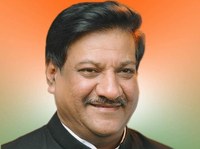 "Some areas of S&T will continue to develop at a steady pace, while other areas will experience accelerated growth – at times leading to the discovery of 'leapfrog' technologies that will have a dramatic impact on the economy." The Minister made his remarks in an interview with TWAS editor Daniel Schaffer on the eve of the TWAS 21st General Meeting in Hyderabad.
"Some areas of S&T will continue to develop at a steady pace, while other areas will experience accelerated growth – at times leading to the discovery of 'leapfrog' technologies that will have a dramatic impact on the economy." The Minister made his remarks in an interview with TWAS editor Daniel Schaffer on the eve of the TWAS 21st General Meeting in Hyderabad.
The pace of S&T development may vary from year to year and from field to field. But this much, the Minister believes, is certain: "India will continue to strengthen its S&T capacities by drawing upon traditions that are deeply rooted in its society and civilization."
He points to India's "natural endowments" in such highly analytical fields as mathematics and astronomy, which date back hundreds and, in some cases, thousands of years. He refers to a long list of eminent scientists, including C.V. Raman, J.C. and S.N. Bose, M. Saha and K.S. Krishnan. And he cites the willingness – indeed eagerness – of India's first Prime Minister Jawaharlal Nehru to invest in science and technology following independence as a compelling example of an unwavering national commitment to S&T "even when the country was seemingly too poor to do so." Successive governments have embraced similar strategies.
India's persistence in building its S&T capacity is now paying big dividends for the economy. Between 1991 and 2004, the country's gross domestic product grew by about 7% a year. Since 2004, except for a sharp downturn that accompanied the global economic crisis in late 2008, the rate of annual growth has accelerated to about 9%.
The Minister readily acknowledges that other factors have played a central role in the progress that has been achieved. He points to the broad measures to liberalize the economy, orchestrated by then Minister of Finance and now Prime Minister Manmohan Singh, beginning in the early 1990s and continuing to the present, as a primary reason for India's recent economic success.
But he is quick to add that one of the most critical drivers behind India's economic growth has been the country's growing capacity in S&T. Prime Minister Singh, for example, has also called for a doubling of public investments in research and development (R&D) and the creation of a vastly expanded network of S&T institutions.
"The first significant impact of S&T on the economy took place in the agricultural sector during the 1960s with the Green Revolution," Chavan notes. "This not only allowed India to gain self-sufficiency in feeding its people but also galvanized public support for S&T."
The second significant impact occurred with the growth of defence-related R&D in the 1970s and 1980s. "Investments in defence-related R&D," he says, "helped expand a number of sectors ranging from food processing to space science."
The third significant impact, he says, occurred with the liberalization of the economy in the 1990s. This not only helped to open S&T in India to both international collaboration and competition. It also helped to spur economic growth. "Increased wealth," Chavan observes, "has generated larger investments in S&T."
Today, India is recognized for S&T excellence in a growing number of areas, including, information and communication technologies, biotechnology, pharmaceuticals, space science and nanotechnology. These and other fields are supported by a large pool of scientists and technologists – for example, India graduates some 700,000 engineers each year.
Progress is undeniable. But the Minister would be the first to admit that serious challenges remain.
India, he says, must continue to increase its investment in S&T. "We now spend about 1% of our GDP on R&D. I hope we can raise this figure to 2% in the years ahead." He also observes that 75% of the investment in R&D currently comes from the public sector and only 25% from the private sector. "I hope that the private sector's share of expenditures will eventually reach 50%." Greater involvement of the private sector, he asserts, "will help expand the impact of S&T on the economy."
Most significantly, Chavan maintains, India must take steps to engage a larger portion of its population in the emerging knowledge-based S&T-based economy.
This goal, he says, needs to be pursued on a number of fronts. There must be continual efforts to improve the educational system. There must be ongoing initiatives to ensure that the benefits of S&T reach the poorest segments of society. And there must persistent efforts to engage the public in meaningful discussions about the role of S&T in their communities and lives.
"The pace at which India has built its scientific and technological capacity may have been slower than some have wanted," Chavan acknowledges. But recent trends suggest that the country's S&T capacity, built on deeply rooted societal traditions and increasingly effective policies, is now growing at an ever-faster rate.
And that is a primary reason why the Minister believes that the progress India has made over the past several decades is just a prelude for better things to come.
• • •
You may also be interested in the article INDIA RISING in the current issue of the TWAS Newsletter.

